The Impact of Dividend Policy on Firm Performance: Shell Plc Study
VerifiedAdded on 2023/04/07
|35
|7539
|243
Report
AI Summary
This report investigates the relationship between dividend policy and firm performance, specifically focusing on Shell Plc. The study examines the impact of dividend policy on key financial variables such as Earnings Per Share (EPS), Price-to-Earnings Ratio (P/E), Dividend Payout Ratio (DPOR), Return on Assets (ROA), and Return on Equity (ROE). The research utilizes annual reports from Shell Plc and employs regression analysis to assess the correlation between these variables. The findings reveal an insignificant relationship between the independent variables (EPS, P/E, DPOR) and the dependent variables (ROA and ROE), leading to the rejection of the alternative hypotheses. Based on these results, the report recommends that Shell Plc develop a unique dividend policy structure, considering market value and the complexities of the current market environment. The study includes an overview of the company, key concepts, related theories like Agency Theory, Residual Theory, and Bird in Hand Theory, and a review of recent research on the topic.
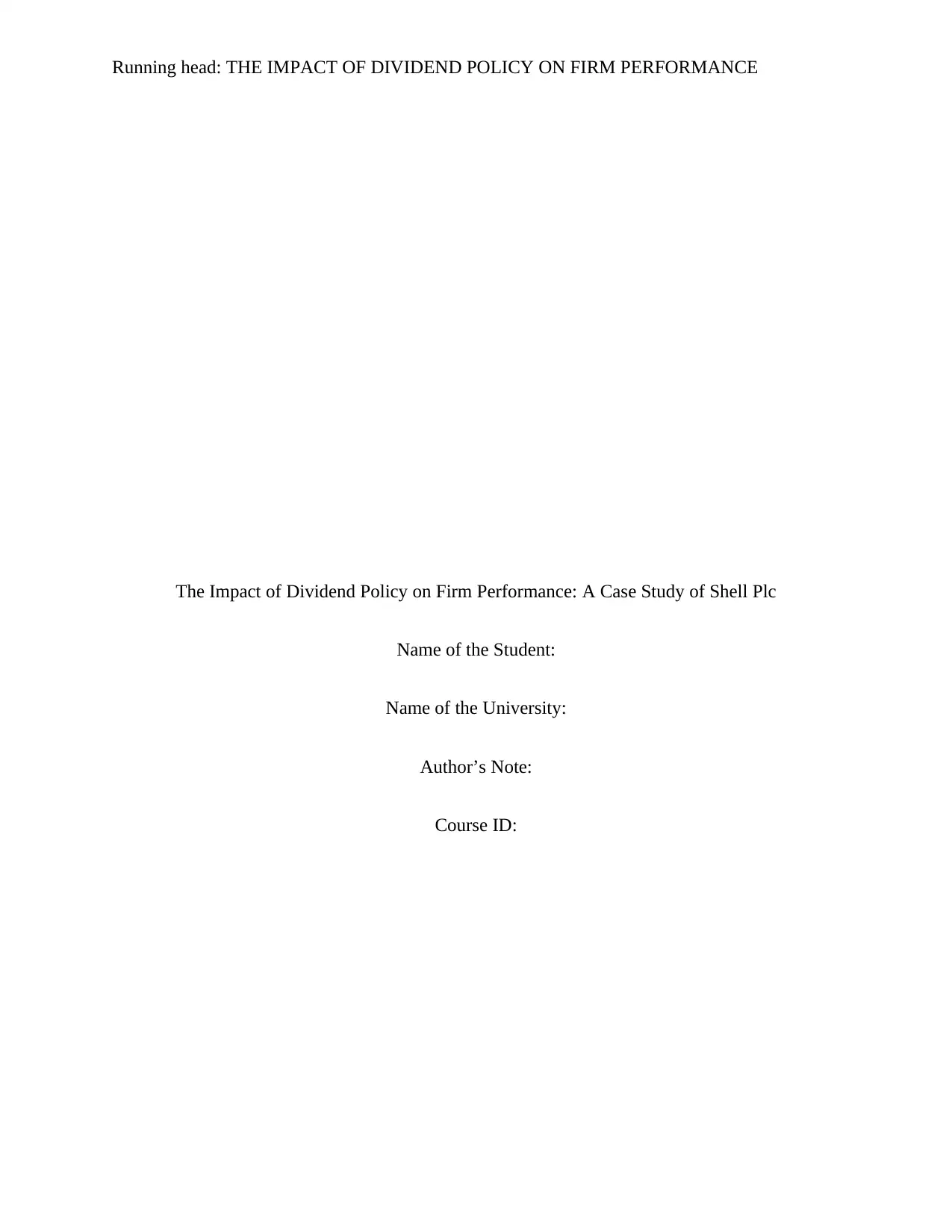
Running head: THE IMPACT OF DIVIDEND POLICY ON FIRM PERFORMANCE
The Impact of Dividend Policy on Firm Performance: A Case Study of Shell Plc
Name of the Student:
Name of the University:
Author’s Note:
Course ID:
The Impact of Dividend Policy on Firm Performance: A Case Study of Shell Plc
Name of the Student:
Name of the University:
Author’s Note:
Course ID:
Paraphrase This Document
Need a fresh take? Get an instant paraphrase of this document with our AI Paraphraser
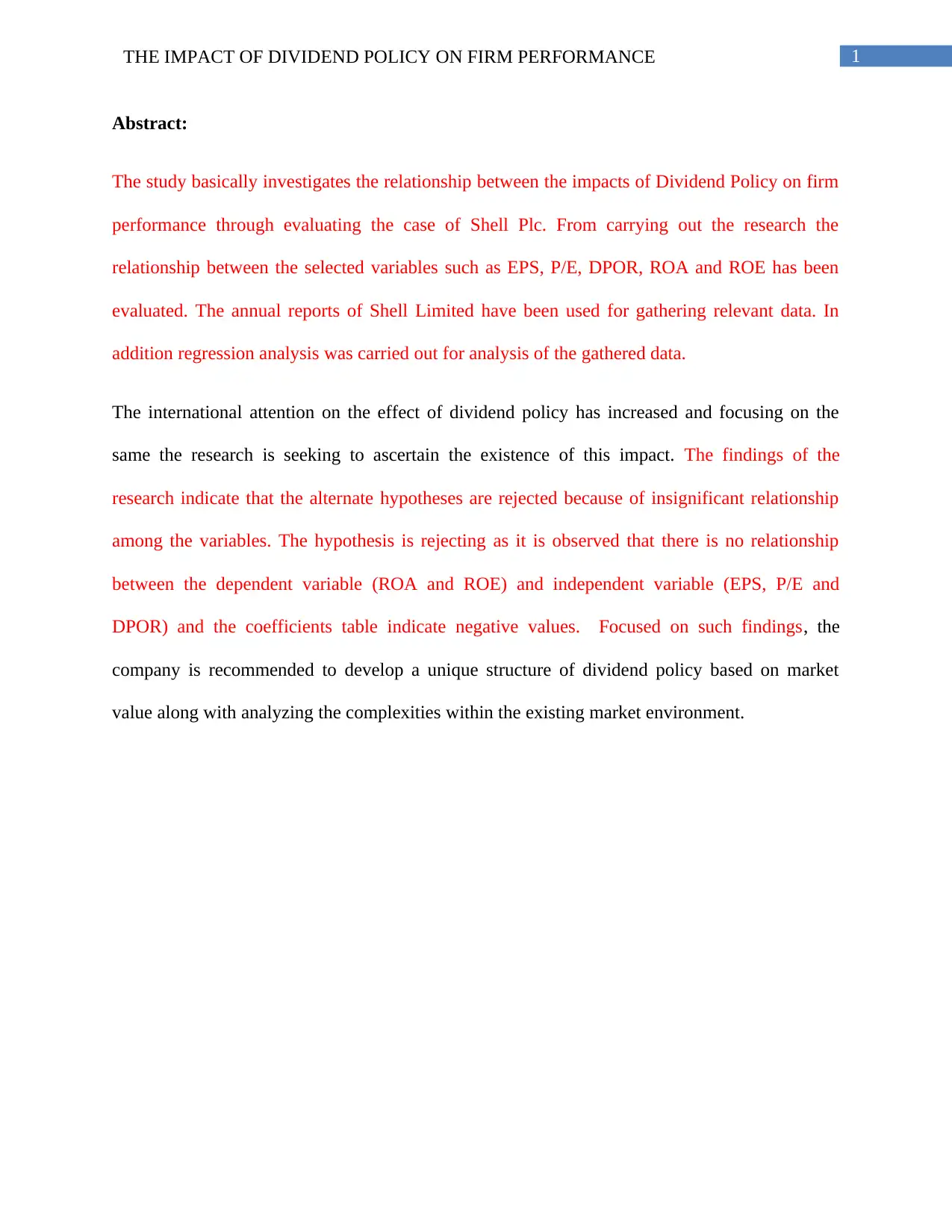
THE IMPACT OF DIVIDEND POLICY ON FIRM PERFORMANCE 1
Abstract:
The study basically investigates the relationship between the impacts of Dividend Policy on firm
performance through evaluating the case of Shell Plc. From carrying out the research the
relationship between the selected variables such as EPS, P/E, DPOR, ROA and ROE has been
evaluated. The annual reports of Shell Limited have been used for gathering relevant data. In
addition regression analysis was carried out for analysis of the gathered data.
The international attention on the effect of dividend policy has increased and focusing on the
same the research is seeking to ascertain the existence of this impact. The findings of the
research indicate that the alternate hypotheses are rejected because of insignificant relationship
among the variables. The hypothesis is rejecting as it is observed that there is no relationship
between the dependent variable (ROA and ROE) and independent variable (EPS, P/E and
DPOR) and the coefficients table indicate negative values. Focused on such findings, the
company is recommended to develop a unique structure of dividend policy based on market
value along with analyzing the complexities within the existing market environment.
Abstract:
The study basically investigates the relationship between the impacts of Dividend Policy on firm
performance through evaluating the case of Shell Plc. From carrying out the research the
relationship between the selected variables such as EPS, P/E, DPOR, ROA and ROE has been
evaluated. The annual reports of Shell Limited have been used for gathering relevant data. In
addition regression analysis was carried out for analysis of the gathered data.
The international attention on the effect of dividend policy has increased and focusing on the
same the research is seeking to ascertain the existence of this impact. The findings of the
research indicate that the alternate hypotheses are rejected because of insignificant relationship
among the variables. The hypothesis is rejecting as it is observed that there is no relationship
between the dependent variable (ROA and ROE) and independent variable (EPS, P/E and
DPOR) and the coefficients table indicate negative values. Focused on such findings, the
company is recommended to develop a unique structure of dividend policy based on market
value along with analyzing the complexities within the existing market environment.
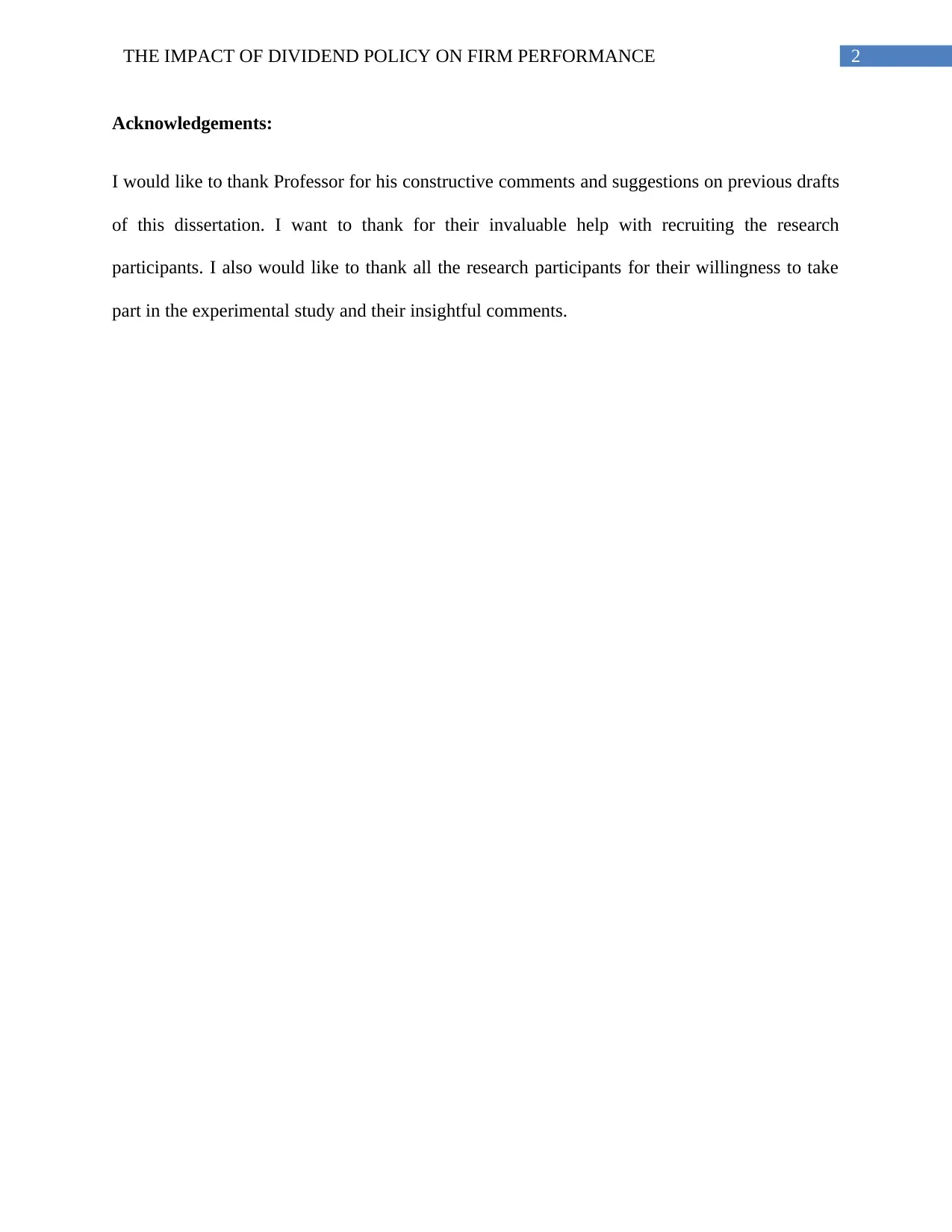
2THE IMPACT OF DIVIDEND POLICY ON FIRM PERFORMANCE
Acknowledgements:
I would like to thank Professor for his constructive comments and suggestions on previous drafts
of this dissertation. I want to thank for their invaluable help with recruiting the research
participants. I also would like to thank all the research participants for their willingness to take
part in the experimental study and their insightful comments.
Acknowledgements:
I would like to thank Professor for his constructive comments and suggestions on previous drafts
of this dissertation. I want to thank for their invaluable help with recruiting the research
participants. I also would like to thank all the research participants for their willingness to take
part in the experimental study and their insightful comments.
⊘ This is a preview!⊘
Do you want full access?
Subscribe today to unlock all pages.

Trusted by 1+ million students worldwide
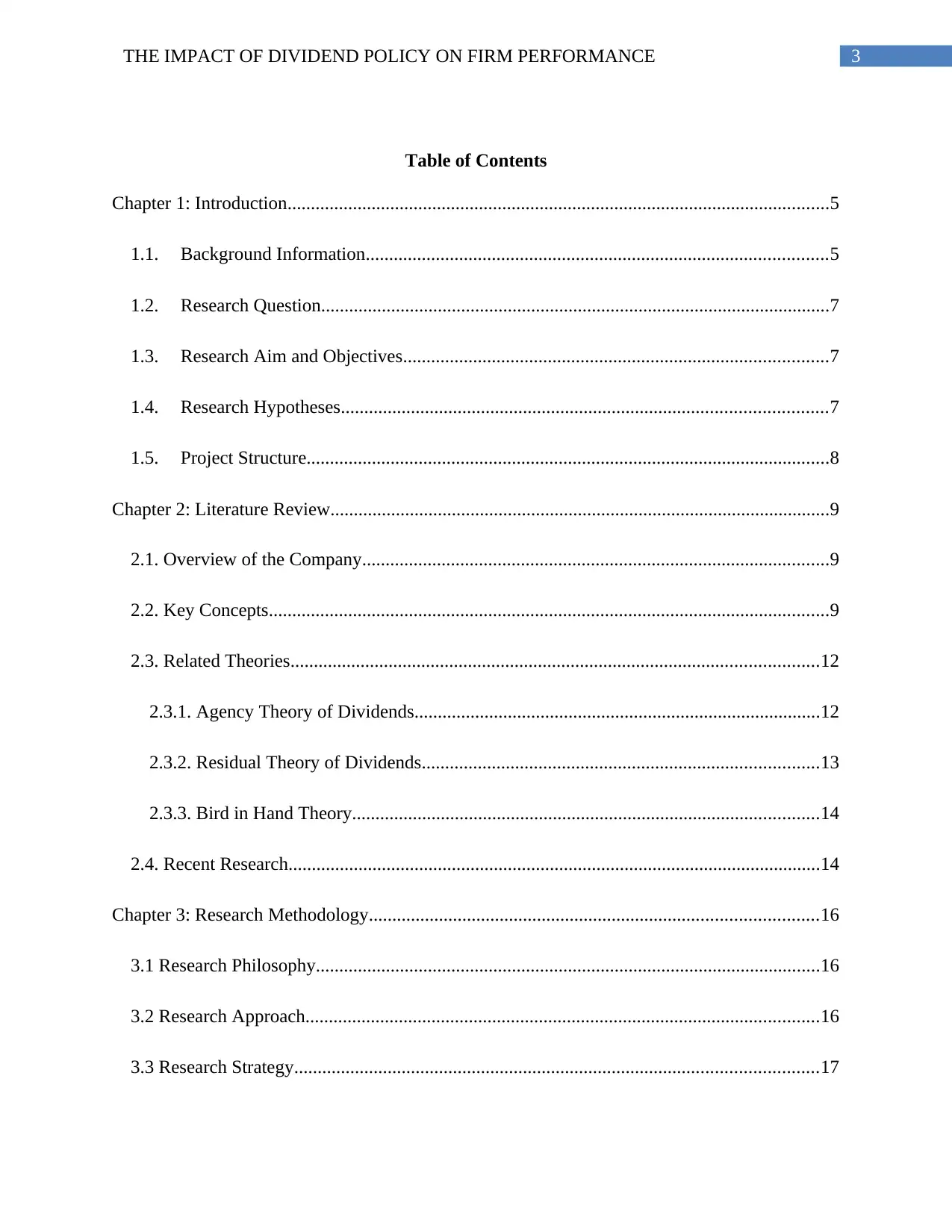
3THE IMPACT OF DIVIDEND POLICY ON FIRM PERFORMANCE
Table of Contents
Chapter 1: Introduction....................................................................................................................5
1.1. Background Information...................................................................................................5
1.2. Research Question.............................................................................................................7
1.3. Research Aim and Objectives...........................................................................................7
1.4. Research Hypotheses........................................................................................................7
1.5. Project Structure................................................................................................................8
Chapter 2: Literature Review...........................................................................................................9
2.1. Overview of the Company....................................................................................................9
2.2. Key Concepts........................................................................................................................9
2.3. Related Theories.................................................................................................................12
2.3.1. Agency Theory of Dividends.......................................................................................12
2.3.2. Residual Theory of Dividends.....................................................................................13
2.3.3. Bird in Hand Theory....................................................................................................14
2.4. Recent Research..................................................................................................................14
Chapter 3: Research Methodology................................................................................................16
3.1 Research Philosophy............................................................................................................16
3.2 Research Approach..............................................................................................................16
3.3 Research Strategy................................................................................................................17
Table of Contents
Chapter 1: Introduction....................................................................................................................5
1.1. Background Information...................................................................................................5
1.2. Research Question.............................................................................................................7
1.3. Research Aim and Objectives...........................................................................................7
1.4. Research Hypotheses........................................................................................................7
1.5. Project Structure................................................................................................................8
Chapter 2: Literature Review...........................................................................................................9
2.1. Overview of the Company....................................................................................................9
2.2. Key Concepts........................................................................................................................9
2.3. Related Theories.................................................................................................................12
2.3.1. Agency Theory of Dividends.......................................................................................12
2.3.2. Residual Theory of Dividends.....................................................................................13
2.3.3. Bird in Hand Theory....................................................................................................14
2.4. Recent Research..................................................................................................................14
Chapter 3: Research Methodology................................................................................................16
3.1 Research Philosophy............................................................................................................16
3.2 Research Approach..............................................................................................................16
3.3 Research Strategy................................................................................................................17
Paraphrase This Document
Need a fresh take? Get an instant paraphrase of this document with our AI Paraphraser
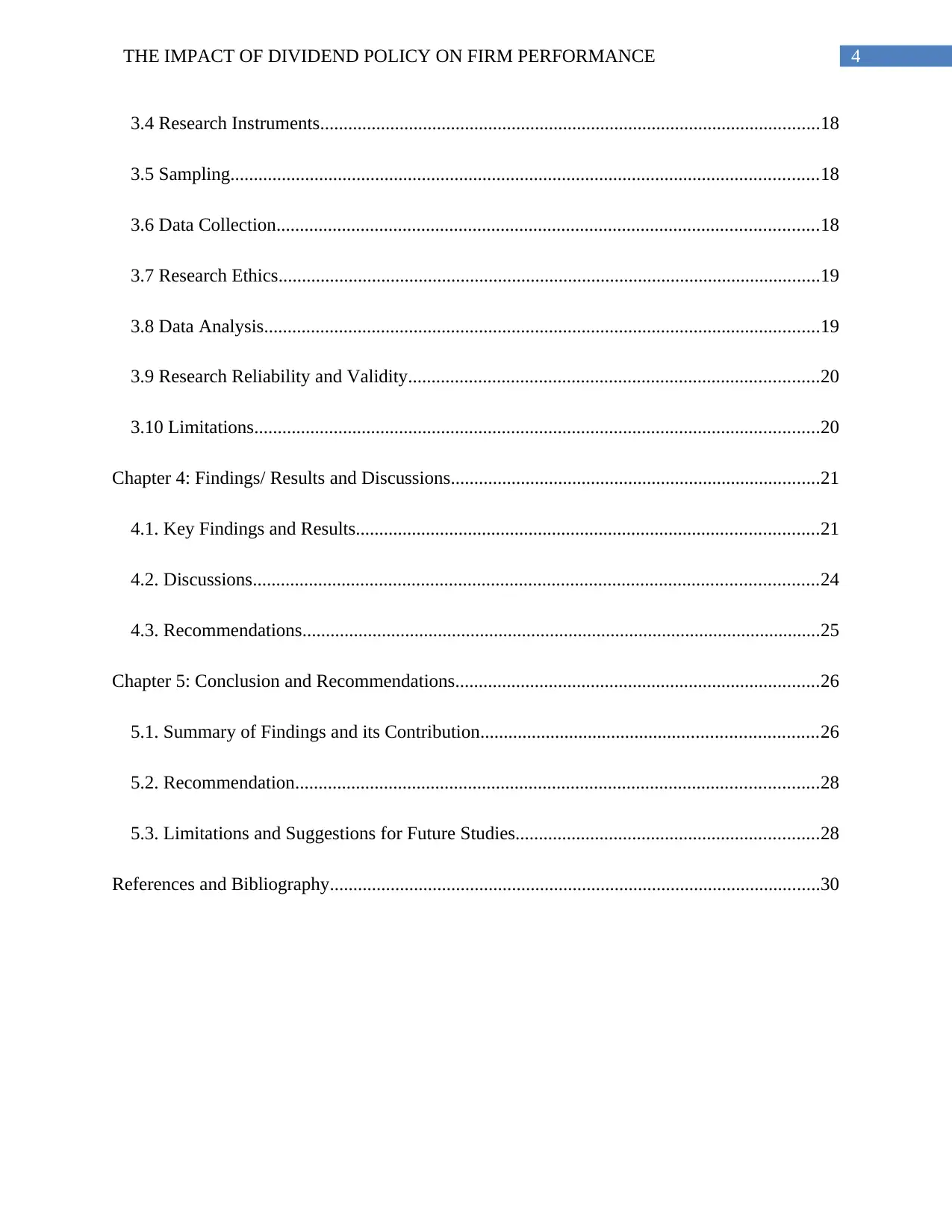
4THE IMPACT OF DIVIDEND POLICY ON FIRM PERFORMANCE
3.4 Research Instruments...........................................................................................................18
3.5 Sampling..............................................................................................................................18
3.6 Data Collection....................................................................................................................18
3.7 Research Ethics....................................................................................................................19
3.8 Data Analysis.......................................................................................................................19
3.9 Research Reliability and Validity........................................................................................20
3.10 Limitations.........................................................................................................................20
Chapter 4: Findings/ Results and Discussions...............................................................................21
4.1. Key Findings and Results...................................................................................................21
4.2. Discussions.........................................................................................................................24
4.3. Recommendations...............................................................................................................25
Chapter 5: Conclusion and Recommendations..............................................................................26
5.1. Summary of Findings and its Contribution........................................................................26
5.2. Recommendation................................................................................................................28
5.3. Limitations and Suggestions for Future Studies.................................................................28
References and Bibliography.........................................................................................................30
3.4 Research Instruments...........................................................................................................18
3.5 Sampling..............................................................................................................................18
3.6 Data Collection....................................................................................................................18
3.7 Research Ethics....................................................................................................................19
3.8 Data Analysis.......................................................................................................................19
3.9 Research Reliability and Validity........................................................................................20
3.10 Limitations.........................................................................................................................20
Chapter 4: Findings/ Results and Discussions...............................................................................21
4.1. Key Findings and Results...................................................................................................21
4.2. Discussions.........................................................................................................................24
4.3. Recommendations...............................................................................................................25
Chapter 5: Conclusion and Recommendations..............................................................................26
5.1. Summary of Findings and its Contribution........................................................................26
5.2. Recommendation................................................................................................................28
5.3. Limitations and Suggestions for Future Studies.................................................................28
References and Bibliography.........................................................................................................30
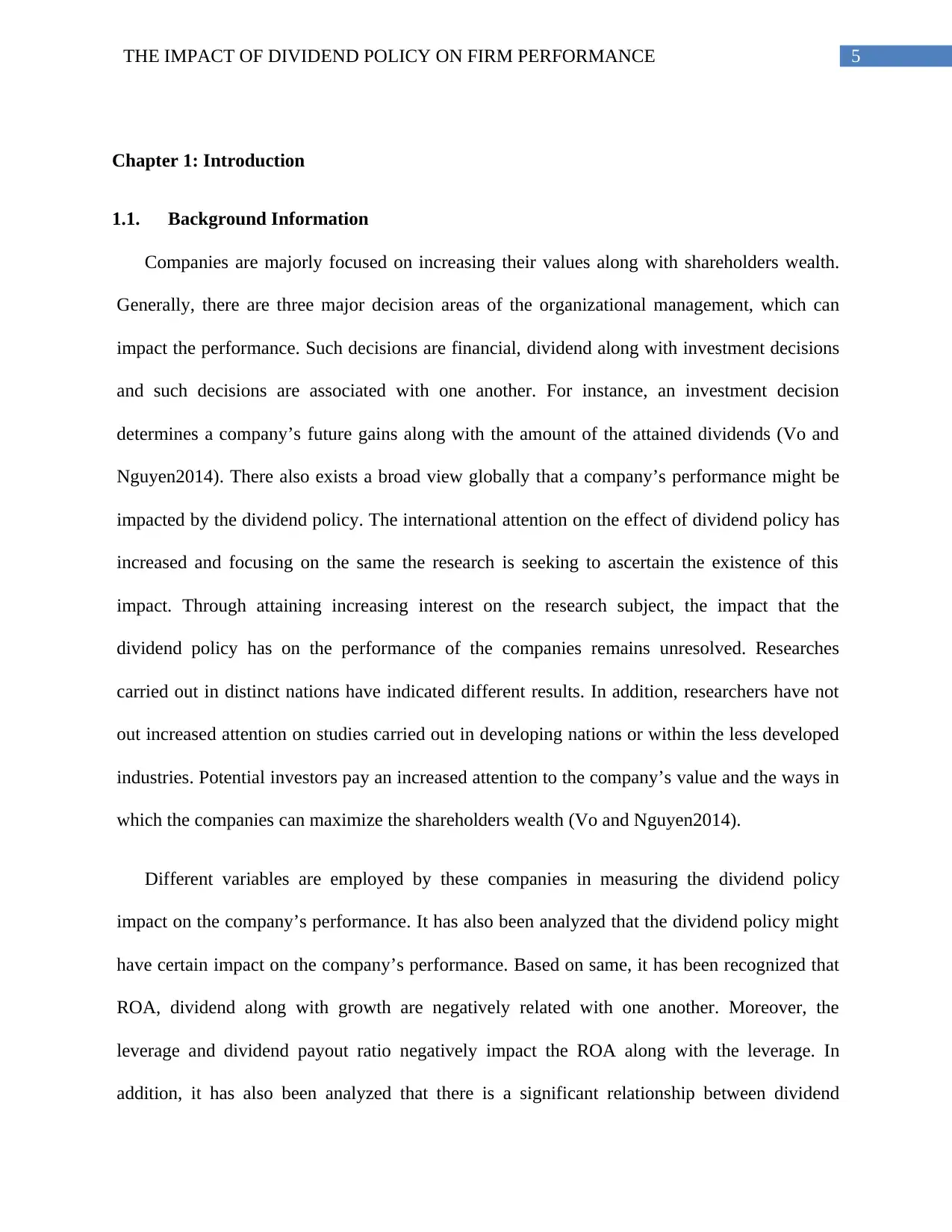
5THE IMPACT OF DIVIDEND POLICY ON FIRM PERFORMANCE
Chapter 1: Introduction
1.1. Background Information
Companies are majorly focused on increasing their values along with shareholders wealth.
Generally, there are three major decision areas of the organizational management, which can
impact the performance. Such decisions are financial, dividend along with investment decisions
and such decisions are associated with one another. For instance, an investment decision
determines a company’s future gains along with the amount of the attained dividends (Vo and
Nguyen2014). There also exists a broad view globally that a company’s performance might be
impacted by the dividend policy. The international attention on the effect of dividend policy has
increased and focusing on the same the research is seeking to ascertain the existence of this
impact. Through attaining increasing interest on the research subject, the impact that the
dividend policy has on the performance of the companies remains unresolved. Researches
carried out in distinct nations have indicated different results. In addition, researchers have not
out increased attention on studies carried out in developing nations or within the less developed
industries. Potential investors pay an increased attention to the company’s value and the ways in
which the companies can maximize the shareholders wealth (Vo and Nguyen2014).
Different variables are employed by these companies in measuring the dividend policy
impact on the company’s performance. It has also been analyzed that the dividend policy might
have certain impact on the company’s performance. Based on same, it has been recognized that
ROA, dividend along with growth are negatively related with one another. Moreover, the
leverage and dividend payout ratio negatively impact the ROA along with the leverage. In
addition, it has also been analyzed that there is a significant relationship between dividend
Chapter 1: Introduction
1.1. Background Information
Companies are majorly focused on increasing their values along with shareholders wealth.
Generally, there are three major decision areas of the organizational management, which can
impact the performance. Such decisions are financial, dividend along with investment decisions
and such decisions are associated with one another. For instance, an investment decision
determines a company’s future gains along with the amount of the attained dividends (Vo and
Nguyen2014). There also exists a broad view globally that a company’s performance might be
impacted by the dividend policy. The international attention on the effect of dividend policy has
increased and focusing on the same the research is seeking to ascertain the existence of this
impact. Through attaining increasing interest on the research subject, the impact that the
dividend policy has on the performance of the companies remains unresolved. Researches
carried out in distinct nations have indicated different results. In addition, researchers have not
out increased attention on studies carried out in developing nations or within the less developed
industries. Potential investors pay an increased attention to the company’s value and the ways in
which the companies can maximize the shareholders wealth (Vo and Nguyen2014).
Different variables are employed by these companies in measuring the dividend policy
impact on the company’s performance. It has also been analyzed that the dividend policy might
have certain impact on the company’s performance. Based on same, it has been recognized that
ROA, dividend along with growth are negatively related with one another. Moreover, the
leverage and dividend payout ratio negatively impact the ROA along with the leverage. In
addition, it has also been analyzed that there is a significant relationship between dividend
⊘ This is a preview!⊘
Do you want full access?
Subscribe today to unlock all pages.

Trusted by 1+ million students worldwide
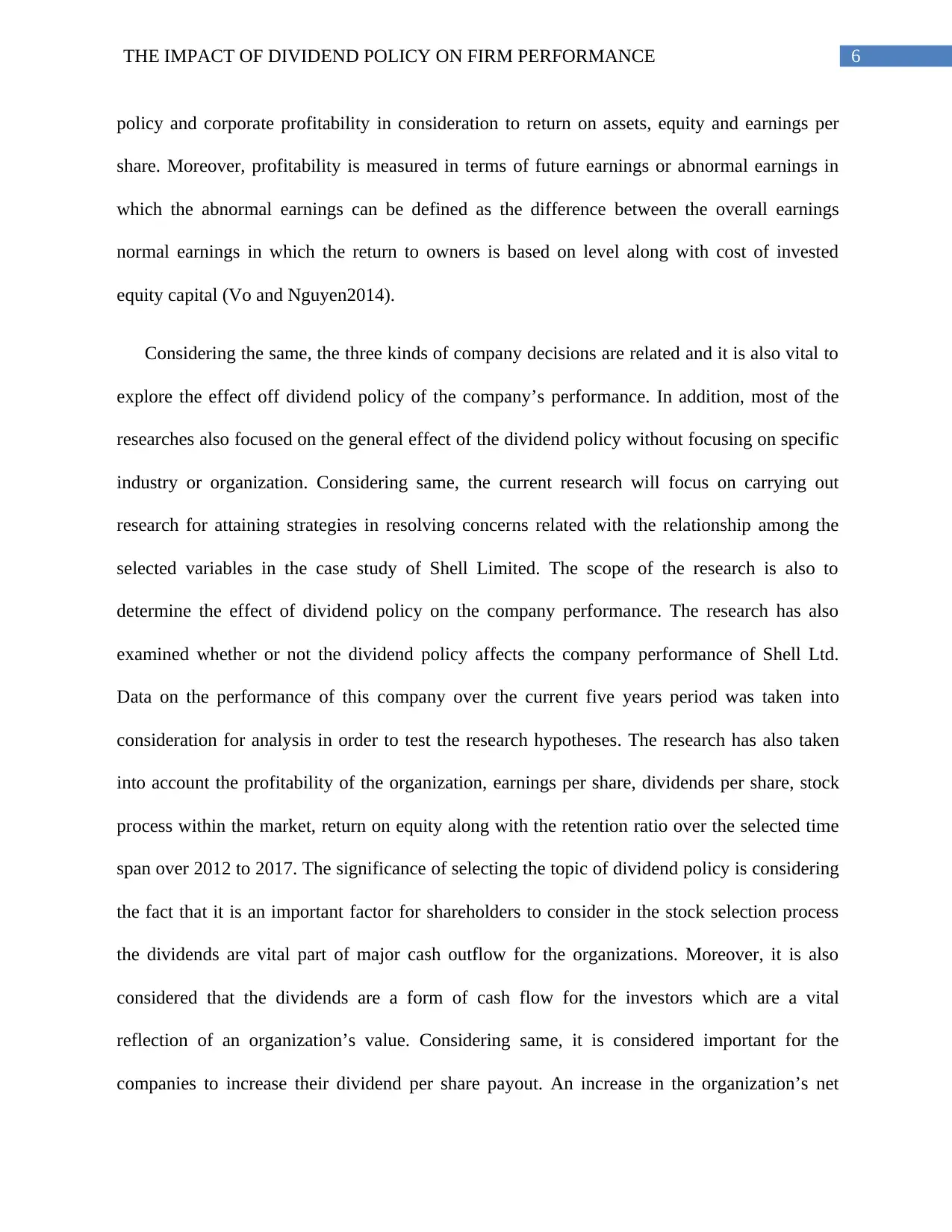
6THE IMPACT OF DIVIDEND POLICY ON FIRM PERFORMANCE
policy and corporate profitability in consideration to return on assets, equity and earnings per
share. Moreover, profitability is measured in terms of future earnings or abnormal earnings in
which the abnormal earnings can be defined as the difference between the overall earnings
normal earnings in which the return to owners is based on level along with cost of invested
equity capital (Vo and Nguyen2014).
Considering the same, the three kinds of company decisions are related and it is also vital to
explore the effect off dividend policy of the company’s performance. In addition, most of the
researches also focused on the general effect of the dividend policy without focusing on specific
industry or organization. Considering same, the current research will focus on carrying out
research for attaining strategies in resolving concerns related with the relationship among the
selected variables in the case study of Shell Limited. The scope of the research is also to
determine the effect of dividend policy on the company performance. The research has also
examined whether or not the dividend policy affects the company performance of Shell Ltd.
Data on the performance of this company over the current five years period was taken into
consideration for analysis in order to test the research hypotheses. The research has also taken
into account the profitability of the organization, earnings per share, dividends per share, stock
process within the market, return on equity along with the retention ratio over the selected time
span over 2012 to 2017. The significance of selecting the topic of dividend policy is considering
the fact that it is an important factor for shareholders to consider in the stock selection process
the dividends are vital part of major cash outflow for the organizations. Moreover, it is also
considered that the dividends are a form of cash flow for the investors which are a vital
reflection of an organization’s value. Considering same, it is considered important for the
companies to increase their dividend per share payout. An increase in the organization’s net
policy and corporate profitability in consideration to return on assets, equity and earnings per
share. Moreover, profitability is measured in terms of future earnings or abnormal earnings in
which the abnormal earnings can be defined as the difference between the overall earnings
normal earnings in which the return to owners is based on level along with cost of invested
equity capital (Vo and Nguyen2014).
Considering the same, the three kinds of company decisions are related and it is also vital to
explore the effect off dividend policy of the company’s performance. In addition, most of the
researches also focused on the general effect of the dividend policy without focusing on specific
industry or organization. Considering same, the current research will focus on carrying out
research for attaining strategies in resolving concerns related with the relationship among the
selected variables in the case study of Shell Limited. The scope of the research is also to
determine the effect of dividend policy on the company performance. The research has also
examined whether or not the dividend policy affects the company performance of Shell Ltd.
Data on the performance of this company over the current five years period was taken into
consideration for analysis in order to test the research hypotheses. The research has also taken
into account the profitability of the organization, earnings per share, dividends per share, stock
process within the market, return on equity along with the retention ratio over the selected time
span over 2012 to 2017. The significance of selecting the topic of dividend policy is considering
the fact that it is an important factor for shareholders to consider in the stock selection process
the dividends are vital part of major cash outflow for the organizations. Moreover, it is also
considered that the dividends are a form of cash flow for the investors which are a vital
reflection of an organization’s value. Considering same, it is considered important for the
companies to increase their dividend per share payout. An increase in the organization’s net
Paraphrase This Document
Need a fresh take? Get an instant paraphrase of this document with our AI Paraphraser
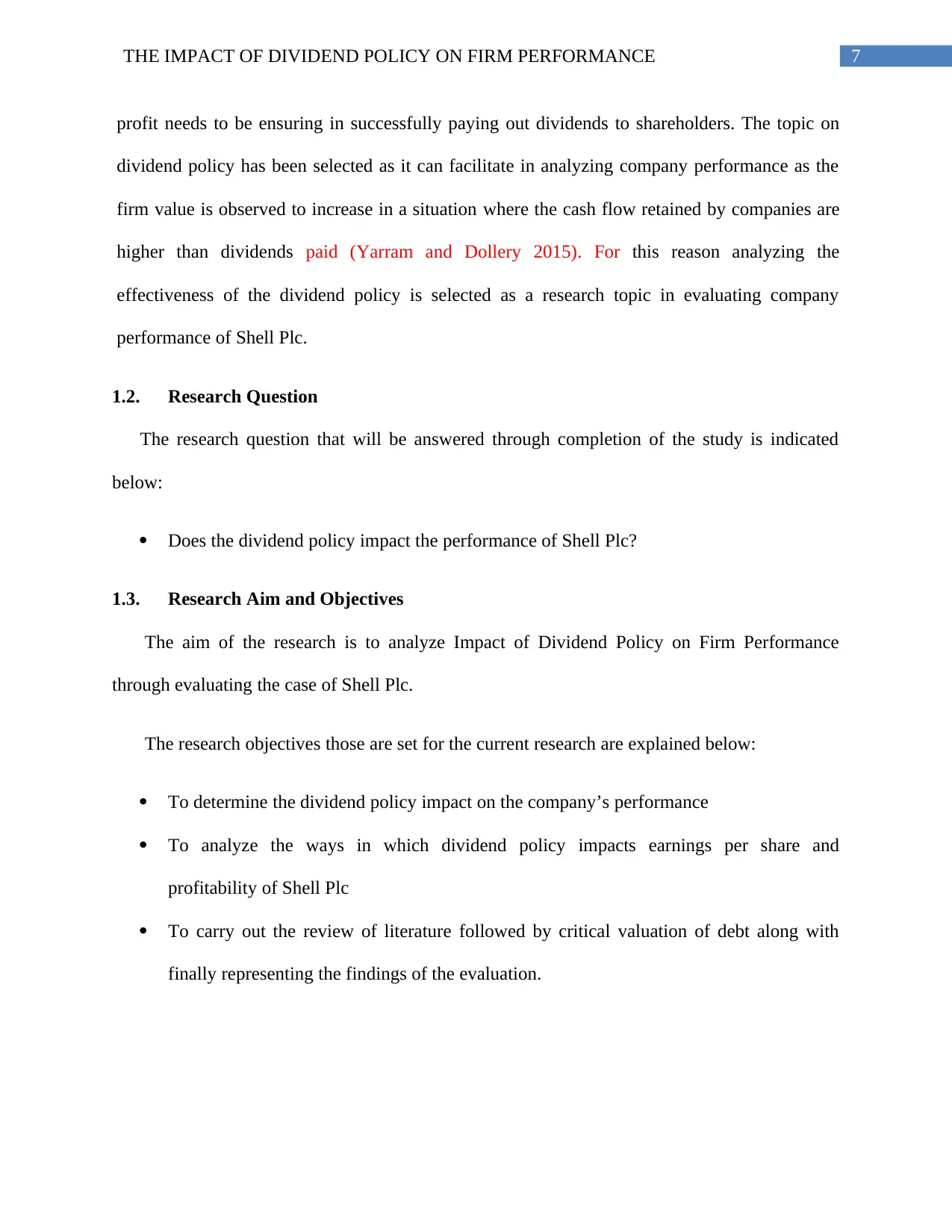
7THE IMPACT OF DIVIDEND POLICY ON FIRM PERFORMANCE
profit needs to be ensuring in successfully paying out dividends to shareholders. The topic on
dividend policy has been selected as it can facilitate in analyzing company performance as the
firm value is observed to increase in a situation where the cash flow retained by companies are
higher than dividends paid (Yarram and Dollery 2015). For this reason analyzing the
effectiveness of the dividend policy is selected as a research topic in evaluating company
performance of Shell Plc.
1.2. Research Question
The research question that will be answered through completion of the study is indicated
below:
Does the dividend policy impact the performance of Shell Plc?
1.3. Research Aim and Objectives
The aim of the research is to analyze Impact of Dividend Policy on Firm Performance
through evaluating the case of Shell Plc.
The research objectives those are set for the current research are explained below:
To determine the dividend policy impact on the company’s performance
To analyze the ways in which dividend policy impacts earnings per share and
profitability of Shell Plc
To carry out the review of literature followed by critical valuation of debt along with
finally representing the findings of the evaluation.
profit needs to be ensuring in successfully paying out dividends to shareholders. The topic on
dividend policy has been selected as it can facilitate in analyzing company performance as the
firm value is observed to increase in a situation where the cash flow retained by companies are
higher than dividends paid (Yarram and Dollery 2015). For this reason analyzing the
effectiveness of the dividend policy is selected as a research topic in evaluating company
performance of Shell Plc.
1.2. Research Question
The research question that will be answered through completion of the study is indicated
below:
Does the dividend policy impact the performance of Shell Plc?
1.3. Research Aim and Objectives
The aim of the research is to analyze Impact of Dividend Policy on Firm Performance
through evaluating the case of Shell Plc.
The research objectives those are set for the current research are explained below:
To determine the dividend policy impact on the company’s performance
To analyze the ways in which dividend policy impacts earnings per share and
profitability of Shell Plc
To carry out the review of literature followed by critical valuation of debt along with
finally representing the findings of the evaluation.
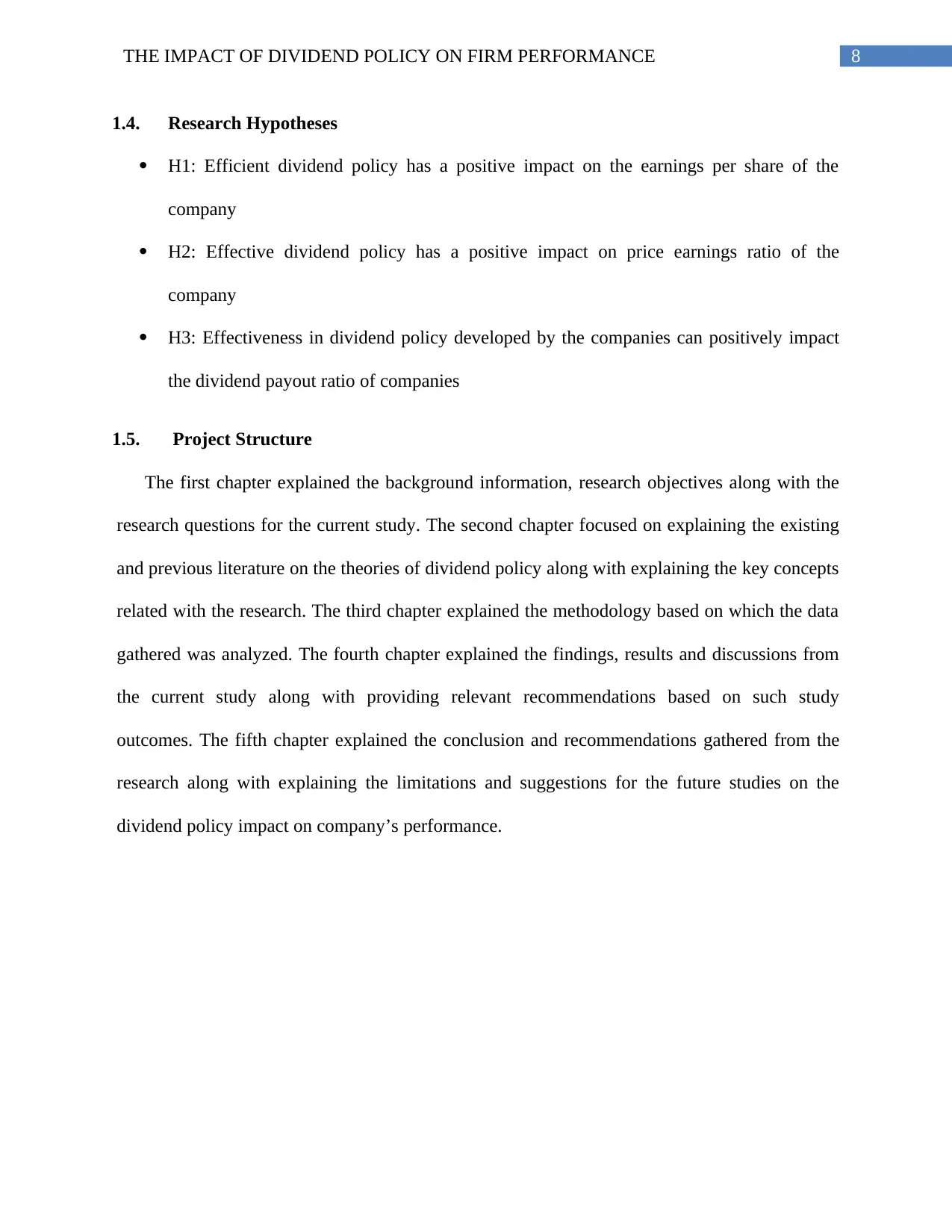
8THE IMPACT OF DIVIDEND POLICY ON FIRM PERFORMANCE
1.4. Research Hypotheses
H1: Efficient dividend policy has a positive impact on the earnings per share of the
company
H2: Effective dividend policy has a positive impact on price earnings ratio of the
company
H3: Effectiveness in dividend policy developed by the companies can positively impact
the dividend payout ratio of companies
1.5. Project Structure
The first chapter explained the background information, research objectives along with the
research questions for the current study. The second chapter focused on explaining the existing
and previous literature on the theories of dividend policy along with explaining the key concepts
related with the research. The third chapter explained the methodology based on which the data
gathered was analyzed. The fourth chapter explained the findings, results and discussions from
the current study along with providing relevant recommendations based on such study
outcomes. The fifth chapter explained the conclusion and recommendations gathered from the
research along with explaining the limitations and suggestions for the future studies on the
dividend policy impact on company’s performance.
1.4. Research Hypotheses
H1: Efficient dividend policy has a positive impact on the earnings per share of the
company
H2: Effective dividend policy has a positive impact on price earnings ratio of the
company
H3: Effectiveness in dividend policy developed by the companies can positively impact
the dividend payout ratio of companies
1.5. Project Structure
The first chapter explained the background information, research objectives along with the
research questions for the current study. The second chapter focused on explaining the existing
and previous literature on the theories of dividend policy along with explaining the key concepts
related with the research. The third chapter explained the methodology based on which the data
gathered was analyzed. The fourth chapter explained the findings, results and discussions from
the current study along with providing relevant recommendations based on such study
outcomes. The fifth chapter explained the conclusion and recommendations gathered from the
research along with explaining the limitations and suggestions for the future studies on the
dividend policy impact on company’s performance.
⊘ This is a preview!⊘
Do you want full access?
Subscribe today to unlock all pages.

Trusted by 1+ million students worldwide
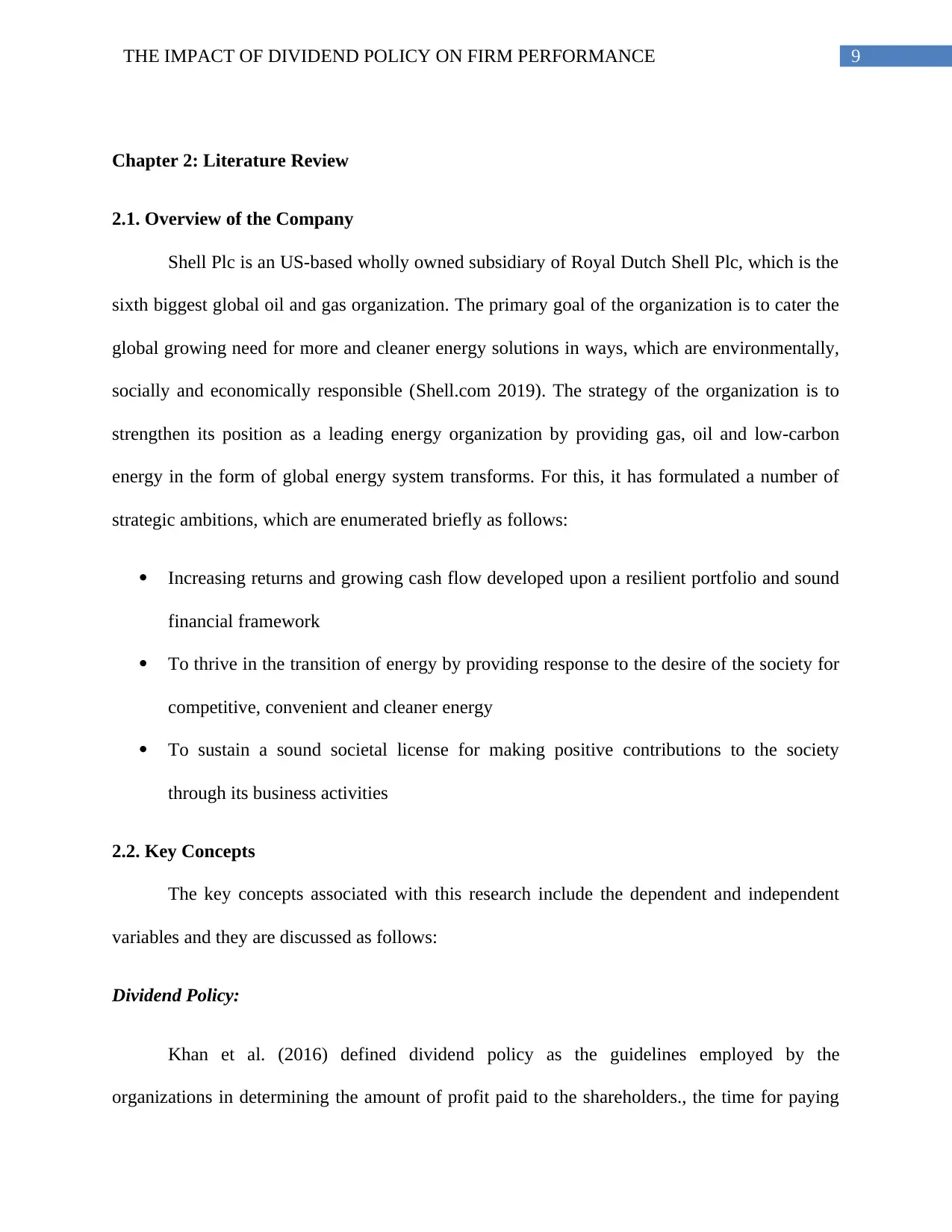
9THE IMPACT OF DIVIDEND POLICY ON FIRM PERFORMANCE
Chapter 2: Literature Review
2.1. Overview of the Company
Shell Plc is an US-based wholly owned subsidiary of Royal Dutch Shell Plc, which is the
sixth biggest global oil and gas organization. The primary goal of the organization is to cater the
global growing need for more and cleaner energy solutions in ways, which are environmentally,
socially and economically responsible (Shell.com 2019). The strategy of the organization is to
strengthen its position as a leading energy organization by providing gas, oil and low-carbon
energy in the form of global energy system transforms. For this, it has formulated a number of
strategic ambitions, which are enumerated briefly as follows:
Increasing returns and growing cash flow developed upon a resilient portfolio and sound
financial framework
To thrive in the transition of energy by providing response to the desire of the society for
competitive, convenient and cleaner energy
To sustain a sound societal license for making positive contributions to the society
through its business activities
2.2. Key Concepts
The key concepts associated with this research include the dependent and independent
variables and they are discussed as follows:
Dividend Policy:
Khan et al. (2016) defined dividend policy as the guidelines employed by the
organizations in determining the amount of profit paid to the shareholders., the time for paying
Chapter 2: Literature Review
2.1. Overview of the Company
Shell Plc is an US-based wholly owned subsidiary of Royal Dutch Shell Plc, which is the
sixth biggest global oil and gas organization. The primary goal of the organization is to cater the
global growing need for more and cleaner energy solutions in ways, which are environmentally,
socially and economically responsible (Shell.com 2019). The strategy of the organization is to
strengthen its position as a leading energy organization by providing gas, oil and low-carbon
energy in the form of global energy system transforms. For this, it has formulated a number of
strategic ambitions, which are enumerated briefly as follows:
Increasing returns and growing cash flow developed upon a resilient portfolio and sound
financial framework
To thrive in the transition of energy by providing response to the desire of the society for
competitive, convenient and cleaner energy
To sustain a sound societal license for making positive contributions to the society
through its business activities
2.2. Key Concepts
The key concepts associated with this research include the dependent and independent
variables and they are discussed as follows:
Dividend Policy:
Khan et al. (2016) defined dividend policy as the guidelines employed by the
organizations in determining the amount of profit paid to the shareholders., the time for paying
Paraphrase This Document
Need a fresh take? Get an instant paraphrase of this document with our AI Paraphraser
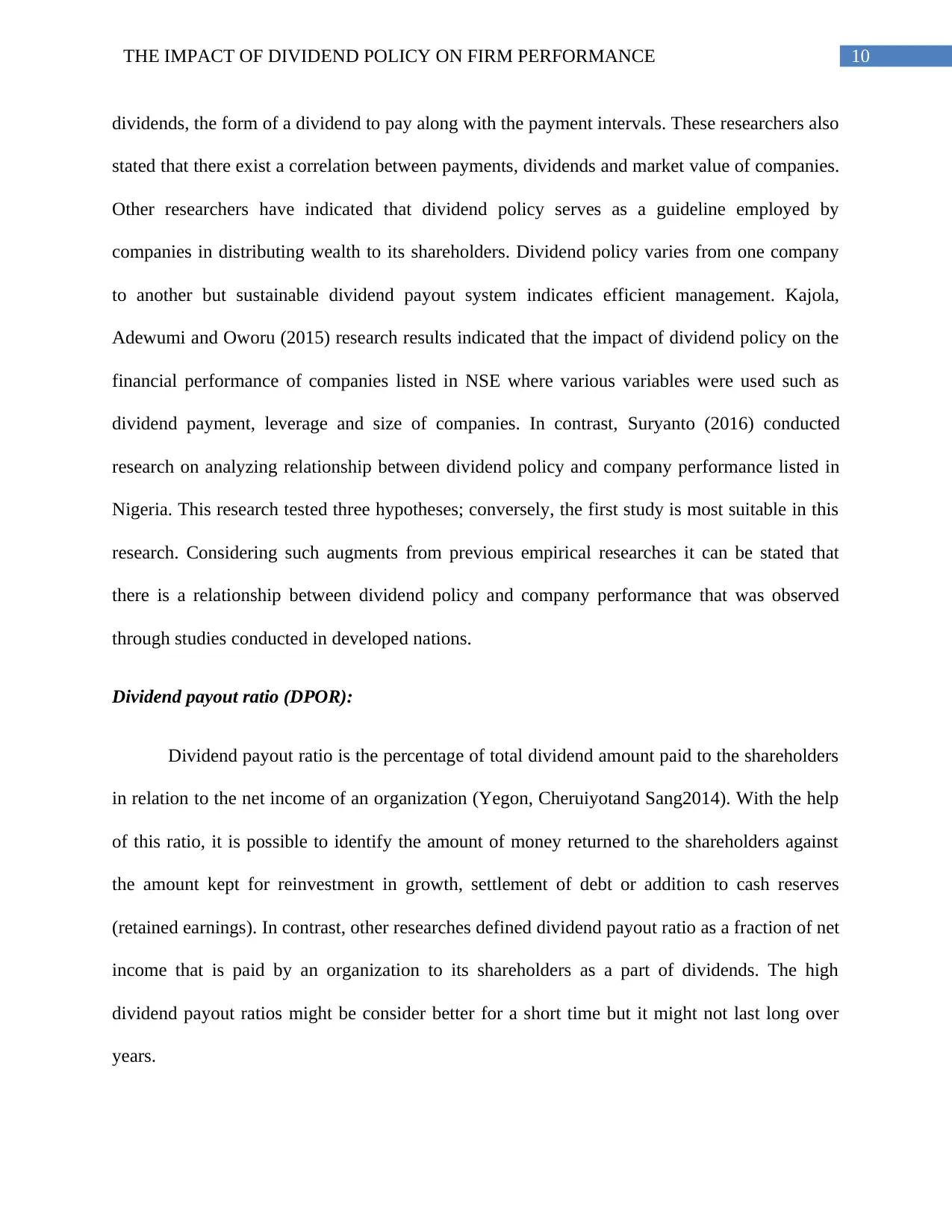
10THE IMPACT OF DIVIDEND POLICY ON FIRM PERFORMANCE
dividends, the form of a dividend to pay along with the payment intervals. These researchers also
stated that there exist a correlation between payments, dividends and market value of companies.
Other researchers have indicated that dividend policy serves as a guideline employed by
companies in distributing wealth to its shareholders. Dividend policy varies from one company
to another but sustainable dividend payout system indicates efficient management. Kajola,
Adewumi and Oworu (2015) research results indicated that the impact of dividend policy on the
financial performance of companies listed in NSE where various variables were used such as
dividend payment, leverage and size of companies. In contrast, Suryanto (2016) conducted
research on analyzing relationship between dividend policy and company performance listed in
Nigeria. This research tested three hypotheses; conversely, the first study is most suitable in this
research. Considering such augments from previous empirical researches it can be stated that
there is a relationship between dividend policy and company performance that was observed
through studies conducted in developed nations.
Dividend payout ratio (DPOR):
Dividend payout ratio is the percentage of total dividend amount paid to the shareholders
in relation to the net income of an organization (Yegon, Cheruiyotand Sang2014). With the help
of this ratio, it is possible to identify the amount of money returned to the shareholders against
the amount kept for reinvestment in growth, settlement of debt or addition to cash reserves
(retained earnings). In contrast, other researches defined dividend payout ratio as a fraction of net
income that is paid by an organization to its shareholders as a part of dividends. The high
dividend payout ratios might be consider better for a short time but it might not last long over
years.
dividends, the form of a dividend to pay along with the payment intervals. These researchers also
stated that there exist a correlation between payments, dividends and market value of companies.
Other researchers have indicated that dividend policy serves as a guideline employed by
companies in distributing wealth to its shareholders. Dividend policy varies from one company
to another but sustainable dividend payout system indicates efficient management. Kajola,
Adewumi and Oworu (2015) research results indicated that the impact of dividend policy on the
financial performance of companies listed in NSE where various variables were used such as
dividend payment, leverage and size of companies. In contrast, Suryanto (2016) conducted
research on analyzing relationship between dividend policy and company performance listed in
Nigeria. This research tested three hypotheses; conversely, the first study is most suitable in this
research. Considering such augments from previous empirical researches it can be stated that
there is a relationship between dividend policy and company performance that was observed
through studies conducted in developed nations.
Dividend payout ratio (DPOR):
Dividend payout ratio is the percentage of total dividend amount paid to the shareholders
in relation to the net income of an organization (Yegon, Cheruiyotand Sang2014). With the help
of this ratio, it is possible to identify the amount of money returned to the shareholders against
the amount kept for reinvestment in growth, settlement of debt or addition to cash reserves
(retained earnings). In contrast, other researches defined dividend payout ratio as a fraction of net
income that is paid by an organization to its shareholders as a part of dividends. The high
dividend payout ratios might be consider better for a short time but it might not last long over
years.
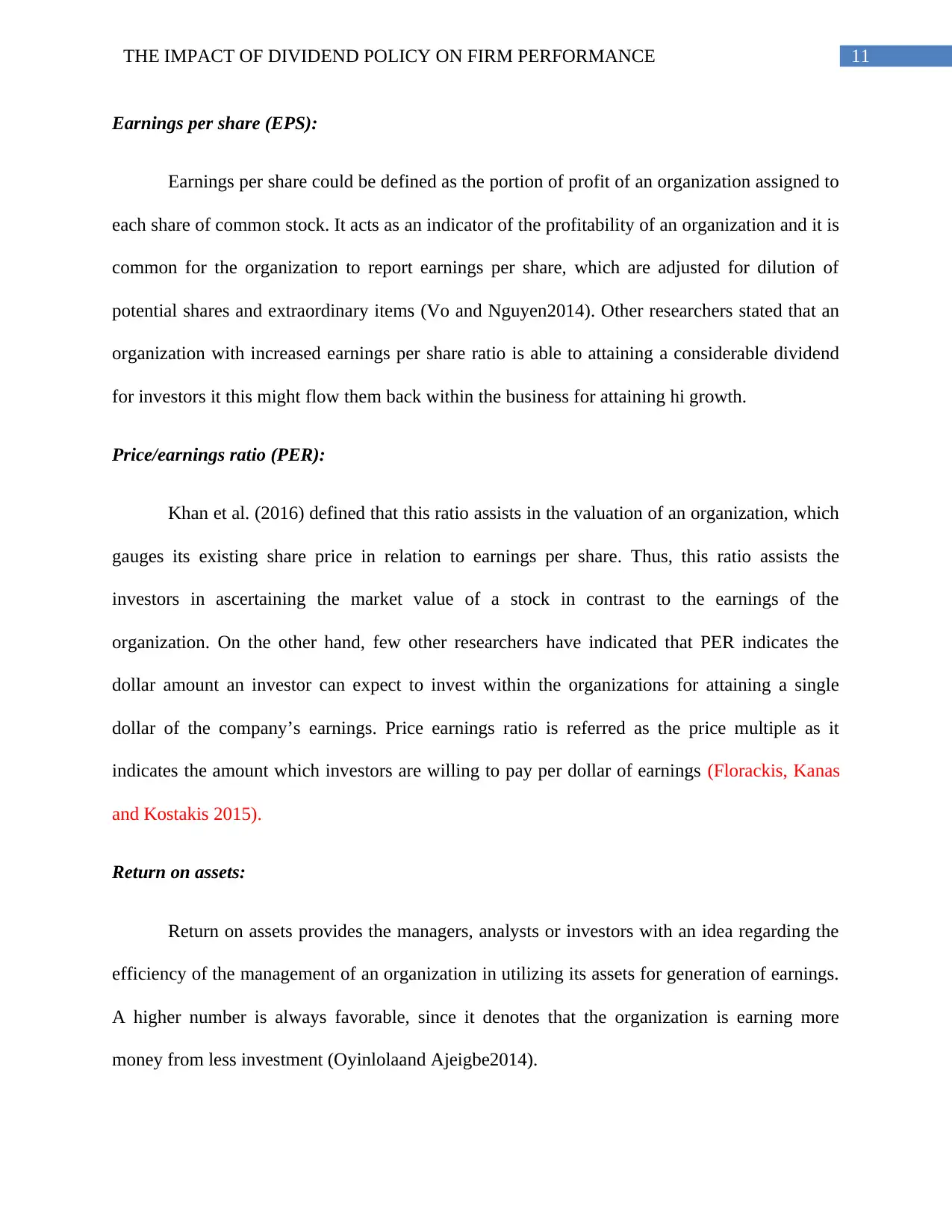
11THE IMPACT OF DIVIDEND POLICY ON FIRM PERFORMANCE
Earnings per share (EPS):
Earnings per share could be defined as the portion of profit of an organization assigned to
each share of common stock. It acts as an indicator of the profitability of an organization and it is
common for the organization to report earnings per share, which are adjusted for dilution of
potential shares and extraordinary items (Vo and Nguyen2014). Other researchers stated that an
organization with increased earnings per share ratio is able to attaining a considerable dividend
for investors it this might flow them back within the business for attaining hi growth.
Price/earnings ratio (PER):
Khan et al. (2016) defined that this ratio assists in the valuation of an organization, which
gauges its existing share price in relation to earnings per share. Thus, this ratio assists the
investors in ascertaining the market value of a stock in contrast to the earnings of the
organization. On the other hand, few other researchers have indicated that PER indicates the
dollar amount an investor can expect to invest within the organizations for attaining a single
dollar of the company’s earnings. Price earnings ratio is referred as the price multiple as it
indicates the amount which investors are willing to pay per dollar of earnings (Florackis, Kanas
and Kostakis 2015).
Return on assets:
Return on assets provides the managers, analysts or investors with an idea regarding the
efficiency of the management of an organization in utilizing its assets for generation of earnings.
A higher number is always favorable, since it denotes that the organization is earning more
money from less investment (Oyinlolaand Ajeigbe2014).
Earnings per share (EPS):
Earnings per share could be defined as the portion of profit of an organization assigned to
each share of common stock. It acts as an indicator of the profitability of an organization and it is
common for the organization to report earnings per share, which are adjusted for dilution of
potential shares and extraordinary items (Vo and Nguyen2014). Other researchers stated that an
organization with increased earnings per share ratio is able to attaining a considerable dividend
for investors it this might flow them back within the business for attaining hi growth.
Price/earnings ratio (PER):
Khan et al. (2016) defined that this ratio assists in the valuation of an organization, which
gauges its existing share price in relation to earnings per share. Thus, this ratio assists the
investors in ascertaining the market value of a stock in contrast to the earnings of the
organization. On the other hand, few other researchers have indicated that PER indicates the
dollar amount an investor can expect to invest within the organizations for attaining a single
dollar of the company’s earnings. Price earnings ratio is referred as the price multiple as it
indicates the amount which investors are willing to pay per dollar of earnings (Florackis, Kanas
and Kostakis 2015).
Return on assets:
Return on assets provides the managers, analysts or investors with an idea regarding the
efficiency of the management of an organization in utilizing its assets for generation of earnings.
A higher number is always favorable, since it denotes that the organization is earning more
money from less investment (Oyinlolaand Ajeigbe2014).
⊘ This is a preview!⊘
Do you want full access?
Subscribe today to unlock all pages.

Trusted by 1+ million students worldwide
1 out of 35
Related Documents
Your All-in-One AI-Powered Toolkit for Academic Success.
+13062052269
info@desklib.com
Available 24*7 on WhatsApp / Email
![[object Object]](/_next/static/media/star-bottom.7253800d.svg)
Unlock your academic potential
Copyright © 2020–2025 A2Z Services. All Rights Reserved. Developed and managed by ZUCOL.





